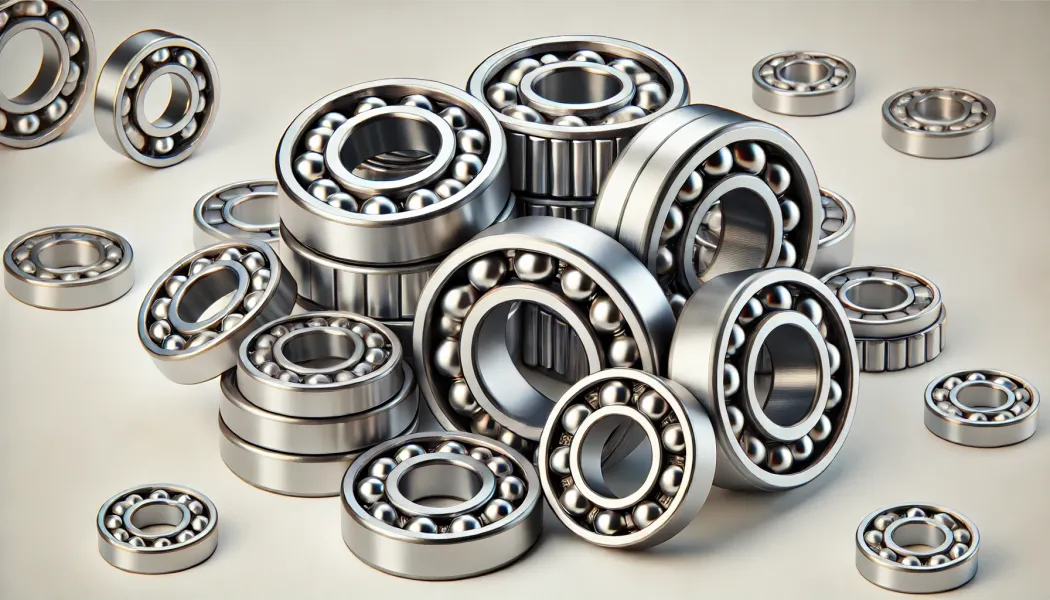Bearings are important elements of mechanical systems that ensure the normal functioning of many types of machinery and equipment with moving parts. They reduce friction between moving parts, increasing the service life of mechanisms and increasing their productivity.
What is a bearing?
A bearing is a mechanical device for supporting rotating or linearly moving parts of machines and mechanisms, reducing friction between them. There are several types of bearings, including ball bearings, roller bearings, needle bearings and many other types, each of which is designed for specific operating conditions.
Why do we need bearings?
Bearings perform several basic functions:
- Friction reduction: reduces friction between the moving parts of the mechanism, which allows them to work more efficiently and with less energy consumption..
- Load support: distributes axial and radial loads, preventing damage to the mechanisms.
- Prolonging the service life: by reducing friction and evenly distributing the load.
- Performance improvement: ensures stable, smooth operation of the mechanisms.

Bearings: types and classification
Most importantly, all types of bearings are divided into two basic classification groups: rolling bearings and plain bearings, and then into subcategories.
The type of bearings can be classified according to several basic criteria:
- By the nature of action: rolling and sliding bearings.
- According to the type of load: radial, axial and radial-axial.
- According to the design features: ball, roller, needle and others.
- According to materials: steel, ceramic, polymer and combined.
Rolling bearings
These are devices that reduce the friction of moving parts using rolling elements: balls or rollers. These elements are placed between the outer and inner rings of the bearing, ensuring uniform and efficient radial movement.
Types of rolling bearings
- Ball bearings (ball bearings)
- Roller bearings (roller bearings)
- Needle bearings
Classification of rolling bearings by rotation speed
- Low-speed bearings less than 300 revolutions per minute
- Medium-speed bearings 300-3000 revolutions per minute
- High-speed bearings from 3000 revolutions per minute
Now let's look at each variety in more detail.
1. Ball bearings
Types of ball bearings
- Radial: supports radical and moderate axial loads.
- Thrust bearings: structurally prepared for increased loads.
- Self-aligning: they are capable of leveling minor shaft deviations.
- With angular contact: suitable for high radial and axial loads.
Advantages of ball bearings:
- Low friction and high rotation rate.
- Uniformity and smoothness of the course.
- Wide range of sizes and models.
Disadvantages of ball bearings:
- Lower load capacity when compared with roller bearings.
- Sensitivity to contamination.
Where are they used
They are in demand in the automotive industry, the manufacture of engines and household appliances, as well as for the manufacture of many other mechanisms, the design of which includes moving parts.
2. Roller bearings
The main types of roller bearings
- Cylindrical: supports large radial loads.
- Conical: demonstrate good resistance to radial and axial loads.
- Spherical: compensate for the angular displacement of the shafts.
Advantages
- High load-bearing capacity
- Resistance to mechanical stress.
- Long service life
Disadvantages
- A more complex mechanism.
- The rotation speed is limited compared to ball bearings.
Applications of roller bearings
They are needed in heavy industry, mining equipment, agricultural machinery, railway transport and construction equipment.
3. Needle bearings
The main types of needle bearings
- Without inner ring: used when the shaft serves as a raceway.
- With inner ring: used when the shaft cannot serve as a raceway.
- With separators: ensure uniform load distribution and minimal friction. With holes: allow lubrication to improve performance.
Advantages
- Compact and space-saving.
- High load capacity.
- Versatility and variety of designs.
Disadvantages:
- Increased friction and wear with insufficient lubrication.
- Limited durability when exposed to high loads and vibrations.
- Sensitivity to contamination.
Areas of application
They are used in the automotive industry (transmissions, gearboxes), light and compact devices (electric motors, compressors), agricultural machinery, machine tools and pumps where work is needed in a limited area.

Sliding bearings
Sliding bearings are mechanical devices that reduce the impact of friction on moving parts by sliding one surface over another. Unlike rolling bearings, they function without rolling elements, due to special liner materials or lubrication.
Areas of use
This type of bearing is widely used in the automotive industry, hydraulic systems and areas where high loads are encountered and resistance to contamination is required.
Classification of plain bearings
By type of load
- Radial bearings: They support loads perpendicular to the axis of rotation. They are widely used in shafts and axial mechanisms to ensure stability and even load distribution.
- Axial bearings: Designed taking into account the impact of loads directed along the axis, they are in demand in units where high axial forces are needed, for example, in turbines and screw gears.
According to the materials of manufacture
- Metal bearings: Made of bronze, brass, aluminum, steel and other metals. They have high strength and resistance to wear, which is why they are necessary for the manufacture of mechanisms designed to work in harsh operating conditions.
- Polymer bearings: Made of nylon, polyethylene, and other high-strength polymers. They have excellent anti-friction properties, low weight and corrosion resistance, which makes them suitable for aggressive environments and light loads.
- Combined bearings: Combine the advantages of metal and polymer materials, usually a metal body with a polymer insert or coating. They have high strength and excellent anti-friction characteristics.
According to the operating conditions
- Dry bearings: Work without lubrication, are made of materials with a low coefficient of friction, such as polymers or special alloys. They are in demand in conditions where the use of lubricants is unacceptable or undesirable, for example, in the food industry.
- Hydraulic bearings: Their principle of operation is based on the use of lubricants to reduce the effect of friction on wear and operation of the mechanism. The lubricant can be applied manually or automatically applied during operation. They are used in most machines and mechanisms where reliable and long-term operation is required.
- Liquid bearings: They work on the basis of hydrodynamic or hydrostatic lubrication, where a thin layer of liquid is formed between the surfaces of the bearing and the shaft, minimizing direct contact between the elements of the mechanism. They are used in high-speed mechanisms exposed to high loads, for example, turbines or pumps.
Housing and support bearings
In addition to plain and rolling bearings, bearing varieties include support and housing types, which play an important role in ensuring reliable operation of various mechanisms.
Housing bearings
Housing bearings are bearings placed in a special housing that provides their protection and support. The housings can be made of various materials such as cast iron, steel or polymers, and they provide easy installation and replacement of bearings.
Types of housing bearings
- Bearing units with cushions: They are shaped like a pillow and are usually mounted on a flat base. They are often used in conveyor systems and agrotechnical complexes.
- Flanged bearing assemblies: Have a flange for mounting and are used in situations where a rigid attachment of the bearing to the structure is required.
- Bearing assemblies with a tensioning device: Provide tension for belts or chains, are used in drive systems.
Support bearings
Support bearings are necessary to ensure the most accurate positioning of rotating shafts and axles with minimal friction, as well as serve to maintain them. They are widely used in the manufacture of mechanisms that require high precision.
Types of support bearings
- Radial thrust bearings: Used in structures where the shaft is subjected to loads perpendicular to the axis of rotation.
- Axial support bearings: Used where the shaft is experiencing loads along the axis of rotation.
- Combined support bearings: They support both radial and axial loads, providing versatility of application.
The use of housing and support bearings
Housing bearings are widely used in the agricultural industry, conveyor systems, construction machinery and industrial equipment. They provide easy installation and replacement of bearings, which simplifies maintenance.
Support bearings are used in precision mechanisms such as machine tools, medical equipment, aerospace engineering and other devices where precision and reliability are important.
How to choose a bearing: tips and recommendations
Bearing selection is an important stage in the design and maintenance of mechanisms. To do this, factors such as the type of bearing, its dimensions, operating load and load must be taken into account.
For the convenience of selecting bearings, size tables are used, which contain information about the ring diameters, width and other parameters. Examples of such tables can be found in the catalogs of bearing manufacturers.
Selection of bearings by size
The selection of a bearing by size includes measuring the diameter of the shaft, the seat and other key parameters. Here are the basic steps to match the bearing size:
- Measure the diameter of the shaft. This is the diameter of the inner ring of the bearing.
- Measure the diameter of the seat. This is the diameter of the outer ring of the bearing.
- Determine the width of the bearing. The width must meet the design requirements.
Selection of bearings by number
Each bearing has its own unique number, which allows you to quickly and accurately select the required type and size. The classification of bearings by numbers facilitates the process of selecting and ordering bearings. Bearing numbers contain information about the type of bearing, its dimensions and additional characteristics.
Classification of bearings by numbers and dimensions
Bearings are classified by numbers, which include information about the type and size of the bearing. For example, the number 6305-ZZ-C3 means:
- 63: Series (deep groove ball bearing).
- 05: Standard size (inner diameter 25 mm).
- ZZ: Performer (metal seals on both sides).
- C3: Accuracy class (increased clearance).

Tips for selecting bearings
- Determine the operating conditions. Take into account the load, rotation speed, temperature and other factors.
- Use the size tables. Refer to the bearing size tables for an accurate selection.
- Check the classification by numbers. Make sure that the bearing number corresponds to the required parameters.
Now you know what types of bearings exist, how to choose and what to pay attention to when choosing it. Use the size tables and the classification of bearings by number and size to accurately and reliably select bearings for your machinery.






